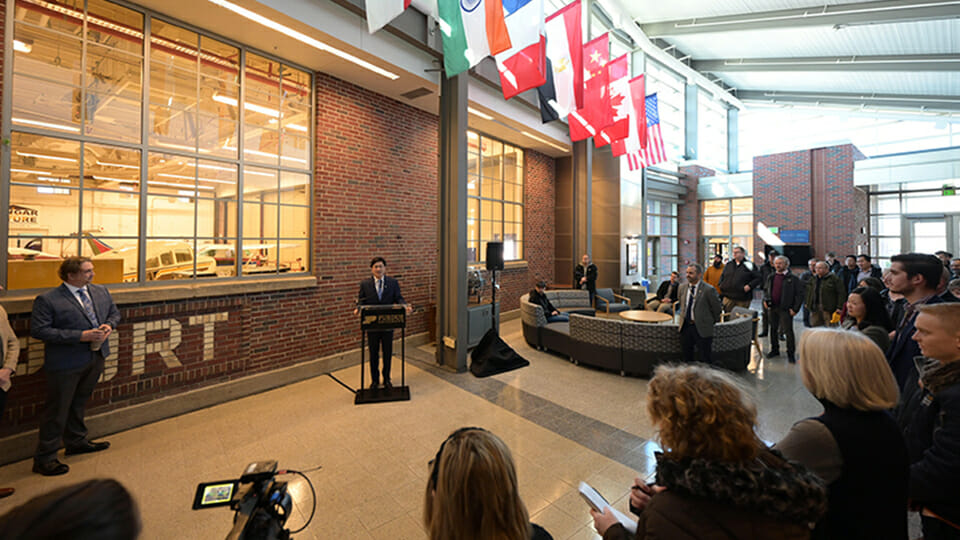Subscriber Benefit
As a subscriber you can listen to articles at work, in the car, or while you work out. Subscribe NowThe Purdue University Airport is partnering with aerospace and defense company Saab and telecommunications business Ericsson to create a 5G network to support research that could improve operations and security at airports, the university announced Monday.
Purdue said the “lab to life” project in West Lafayette will serve as a proving ground for academics, researchers and businesses to test 5G innovations in real-life scenarios.
Troy Hedge, vice president of innovation and technology at the Purdue Research Foundation, said Saab wanted to investigate the potential evolution of its airport security and operations systems.
“They were interested in exploring how those technologies and products that they currently have could actually be migrated and demonstrated to be viable and successful on wireless networks,” Hedge said. “And so by converting them to wireless capability, it improves speed to market, speed of deployment. It provides more flexibility for being able to manage relocations or airport updates.”
As part of the partnership, Sweden-based Ericsson will provide a private 5G network for the Purdue Research Foundation that will operate at the airport, on the southwest side of Purdue’s West Lafayette campus.
Sweden-based Saab will install a platform called Aerobahn, which is designed to create efficiency for airlines and ramp management, as well as the SAFE Event Management security platform used in airport operation centers. Saab will also deploy sensors to track aircraft.
Currently, airports install sensors and systems that require hardwired network connections, point-to-point radio frequency links, or public cellular connections, according to Purdue. The university said the technology used in the partnership with Saab and Ericsson makes that approach obsolete and gives airports more flexibility.
“For [Saab], it’s a big opportunity to say, ‘If we could do this all wirelessly, that gives us a great opportunity to be able to bring our product to market in a much faster and flexible format.’ So that’s an application they were interested in,” said Hedge.
For Ericsson, Hedge said the collaboration serves as a use case for how wireless technology can be leveraged and be of value at airports.
“We are witnessing uptake in global demand for digitalization at airports that requires stable, secure and high-performing wireless networking,” George Mulhern, head of Ericsson Enterprise Wireless Solutions, said in written remarks. “This unique collaboration enables trials and industrialization of 5G applications and use cases that help solve aviation market needs—improving flight safety, enhanced passenger experience, as well as increased efficiencies and cost savings.”
Hedge adds the Purdue Airport, the partnership presents an opportunity to expand its aviation technology portfolio. The airport is the second busiest airport in Indiana; while it doesn’t have commercial traffic, the airport does see a lot of flight training and private charter service.
“With that activity at the airport, it’s a great environment to be able to think about applications for innovation to advance the airport industry,” he said. “With the backdrop of the Purdue University airport, as what I would call the environment, and then to overlay that with advanced sensor technology that Saab is bringing to the table, as well as a 5G wireless network, it becomes kind of a what you might call living laboratory.”
The partners are classifying the collaboration as an open innovation platform that will investigate a variety of potential applications for using 5G wireless technology, such as safely increasing the number of takeoffs and landings that an airport can handle or finding efficiencies in baggage handling and ticketing systems.
The Purdue Research Foundation created the “lab to life” platform as a means to foster collaboration between academia and industry. Hedge said Purdue is open to other third parties getting involved.
“If there are companies that are bringing new technology to airports and they need a place to demonstrate it or validated or optimize it – this place in the middle that’s not research, but it’s not ready for full scale commercialization—our lab life environments are really key asset to really enable that to happen in a productive way.”
Please enable JavaScript to view this content.

